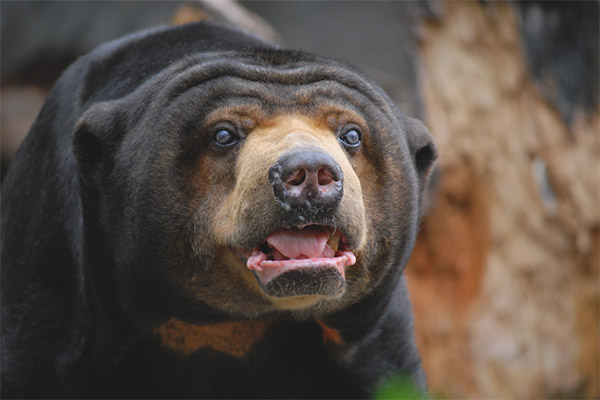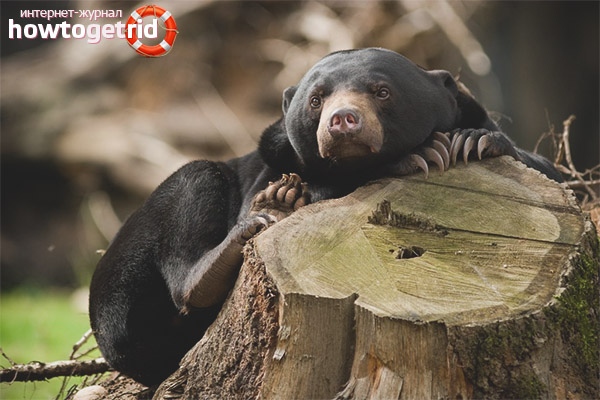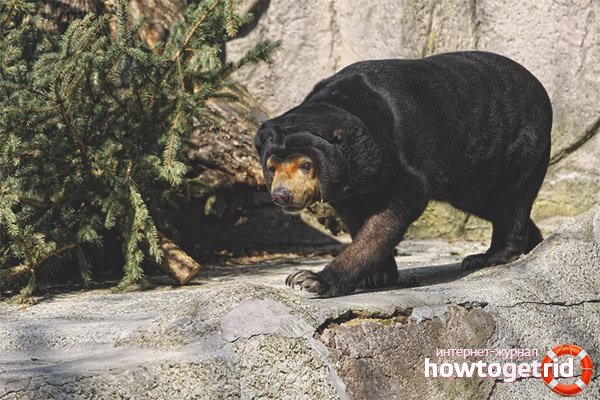The content of the article
Under the Malay bear is meant quite interesting by external features of the beast, which is similar to itself only indirectly. Individuals of this type are listed in the Red Book, protected by law, and therefore any of their persecution is strictly punished.
Description
- The pigmentation of the muzzle is beige with golden splashes or shimmering, it all depends on the individual. The rest of the body is dark brown or black. Among themselves, this species is significantly distinguished by overall characteristics. Individuals grow to 0.7 m. At the withers maximum. As for the length of the body, the figures are approximately 1.5 m. Partly for this reason, the animals look awkward and elongated.
- According to the weight characteristics of the individual are about 70 kg., But more often you can find not such well-fed representatives of the species. The tongue is very long, has a sticky lubricant, can twist the tube or hang like a rope. Animals get honey, feed on inhabitants of termitaries with the help of their tongue.Fangs are pointed and elongated, not like other bears. Animals bite the bark, tearing it off and taking insects.
- Bummed creatures are endowed with beautiful big blue eyes. The visual apparatus is poorly developed, so the bears are called semi-blind. But this is compensated by excellent hearing and smell, which is what the animals themselves are guided by. They have a rather aggressive temper, directly related to poor eyesight. When the clubfoot stumbles upon someone, it starts to get angry at bewilderment. Despite the small weight and dimensions, these persons fight very fiercely.
- Ears set at a certain distance. Small in size, with rounded edges. The shell itself does not grow more than 6 cm in length, although often these indicators are limited to 4 cm. The muzzle in format is extended, short. Claws pointed, strong, elongated. On the neck there are folds of skin, they protect the toe from other predators that usually bite behind withers.
- Bears are very thick-skinned, so it is not easy for wild cats who hunt by this method. If you add on the excessive elasticity of the skin, the cats will be left without lunch for sure.Bears are endowed with crooked limbs, so their club foot is more pronounced than that of the brethren. Coat shortened.
- Despite the miniature dimensions, these animals have a high level of intelligence. They are smarter than themselves and can make decisions in difficult situations. Otherwise, members of the family are called Birouang. If we compare the overall characteristics of average bears, they are similar to large-sized dogs. Also, bears are tied to chains when kept in captivity, as, indeed, dogs.
Habitat
- Quite a large number of individuals dispersed around the island of Borneo. Also there are representatives of the family under discussion in Thailand, Indonesia, and India. They are found on Laos and in Vietnam. Some are common in Sumatra and in southern China.
- The distinctive characteristics include the single character of life. Individuals spend most of their existence upstairs in the trees. The only exceptions are individuals of female gender and their offspring. They try to stay on the site close to the males, which will protect in case of danger.
- The beasts are more awake at night. They like dark and cloudy weather. In the daytime, rest in their shelters. In normal times, a den is built on a tree, using branches and twigs. If suddenly the animal gets to the content in captivity, it is easy to get used to it and will succumb to training.
Breeding
- With the onset of the mating season, the representatives of the stronger sex begin to care for the females around the crescent. Only after that the male manages to win the attention of the chosen one. Then mating occurs. It lasts for several days. The female bears offspring for 200 days.
- After that, up to 3 babies are born. They are completely defenseless, almost devoid of wool and blind. Individuals reach sexual maturity from 3 to 5 years. The first couple of years of life youngsters remain to live with their mother. Milk cubs eat about 4 months. For about 2 months, babies do not leave the shelter at all.
- The cubs begin to run out of the house approximately 2.5–3 months after birth. Sometimes they start to go hunting with their mother. Thus, the offspring are trained in wild life.If you keep an animal in captivity, it can live a quarter of a century. As for wild conditions, bears rarely live to be 18 years old.
- Animals have long been listed in the Red Book. The problem is that the number of this species continues to decline. This is because poachers, despite everything, continue to hunt wild animals. Local healers use the liver and bile of the animal for medicinal purposes to eliminate various ailments. Also, the number of bears is reduced due to the massive deforestation of tropical forests.
Role for man
- Currently, more and more people continue to hunt for individuals rather because of sports interest. Hunters also sell various parts of the animal's body. As mentioned earlier, some organs are used in traditional medicine. Moreover, these drugs have a long history.
- In traditional Chinese medicine, bear bile is still used today. This tool is effective for the treatment and prevention of bacterial infections. Among the local population, there is a belief that such a composition has a great effect on male power. Bile significantly increases libido, in both men and women.
- In addition, the bile of a wild animal is considered a powerful tool for the treatment of fairly serious pathologies. The Chinese claim that even deadly diseases can be cured. Animal hair is mainly used for the manufacture of caps.
- In some regions, individuals play an important role. Animals tolerate the seeds of various plants. Only in one specimen of bear excrement, more than 300 seeds were found, which may well germinate. Otherwise, the animals suffer damage to the harvest of bananas and coconut plantations.
Status
- As mentioned earlier, animals are listed in the Red Book. Such bears are considered one of the rarest among their relatives. There are so few animals that it is not even possible to determine with accuracy how many individuals are left.
- It is noteworthy that every year the numerical wildlife is still declining. Due to the fact that habitual habitats are being destroyed, bears are dying. Individuals are forced to live in isolated territories.
Some residents from those areas where animals are common, compare individuals with aliens. And for good reason, their appearance is similar to the alien one, so the second is not the scientific name of the species - aliens.In today's article, we have studied everything that concerns the representatives of the family, in order to clarify some nuances.
Video: Malay bear (Helarctos malayanus)













To send